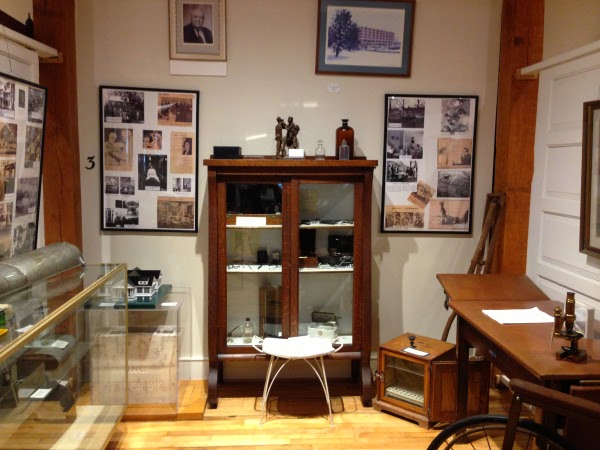
Sometimes people who work in small museums take me to task about some of the technologies I highlight in CFM forecasts (“we can’t afford that!”) When this happens, I point out it’s never really about the technology—it’s about the human desires and behavior that drive the creation of the shiny tech toys. Technology, and tech platforms, may in turn shape the expectations of our audiences, but there are often low-tech or no-tech ways to meet those needs. I invited Allison Weiss, executive director of the Sandy Spring Museum, to blog about a recent experiment with harnessing cultural trends to active participants in the operations of small museums.
I love the idea of integrating pop culture and museums. Who doesn’t love/hate reality TV? Is there anything museums can learn from reality TV? Aside from the obvious voyeur-appeal, I think that we are also attracted to reality shows because we like watching the process, not just seeing the end result. Last spring the staff of the Sandy Spring Museum, which is a small history museum with a staff of 3 FTE and an operating budget of about $385,000, decided to use the appeal of “reality” to recharge our visitation.
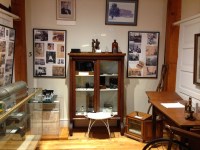 |
| “Before.” Photo by Allison Weiss |
Our exhibits hadn’t changed in fifteen years, and with estimates at $300 a square foot for design and fabrication, building new exhibits was out of the question. And how much would new exhibits accomplish? Probably a small crowd would attend the opening, but considering that our walk-in traffic averages around 10 people on days without programs, that hardly seemed to justify any financial investment in new exhibits. We concluded that in our case, just changing the exhibits was not enough.
So, instead, we borrowed several concepts from reality TV and created the Extreme Exhibit Makeover. We brought together a diverse group of strangers who had to collaborate and compete, and made it into a spectacle. Museums take themselves so seriously. We saw this as an opportunity to inject a little humor into the otherwise somber process of interpreting history.
The project started with a call for participants . We invited curators, exhibit designers, artists, historians, and the general public, and were amazed at the experience of the people who applied, many with decades in the museum field. Nearly all commented on how stale the traditional exhibit process is, and all shared an adventurous spirit.
Participants were divided into two teams – Team Jersey Shore and Team Kardashian – with five participants each and a graphic designer who floated between the two teams. We tried to make the teams fairly evenly matched in expertise and skill, i.e., each team had a designer, an artist, a researcher, etc. Everyone came to the museum for an orientation and to pick sections of the exhibit hall on which they would conduct their makeover. The parameters were very broad: each team was given a $1000 budget, a deadline, and a mandate to have their research verified by volunteers at SSM; otherwise they were given nearly free rein.
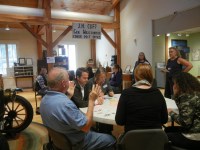 |
| Team Meeting. Photo by Allison Weiss |
It was obvious even during the first meeting that any time you bring two or more people together there is the potential for conflict and disagreement. Within 24 hours, we lost one participant and within two weeks, two more dropped out or, as we prefer to phrase it, got “kicked off the island.” During the ensuing months, life intervened – several participants got jobs, one got engaged. It turned out to be very difficult to keep everyone engaged and focused, which resulted in us having to extend the project deadline. A project blog was updated several times a month to give the public an idea of what was going on behind the scenes.
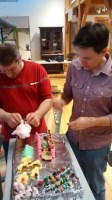 |
| Museum Peeps! |
To me, the highlight of the project was the installation. In true reality TV form, it was a public event and all of the construction had to be done on site during a two-day installation weekend. Graphics were prepared ahead of time but the exhibits, one of which required major construction, were otherwise built on location. To ensure that we incorporated some spectacle into the weekend, Tania Katan, the producer of Shenanigans at the Scottsdale Museum of Contemporary Art, was the MC for the installation and also judged the mini-makeover competition, during which the participants recreated famous moments in Sandy Spring history using marshmallow peeps.
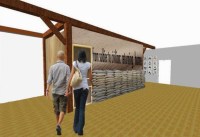 |
| Conceptual drawing by Lynda Barry-Andrews |
The team’s exhibits were vastly different from one another. One team stuck to the concept of “makeover,” making great improvements to a very weak exhibit on general stores. They focused on the concept of “gathering place” and explored ways in which residents historically came together for social purposes and to better the community. The other team de-installed an existing exhibit so they could start from scratch. Their exhibit, From Soldier to Civilian – looked at how a soldier reintegrates into society, drawing from contemporary sources like oral histories, and historic sources from the museum’s archives.
Three “celebrity” judges – Larry O’Reilly (the mastermind behind the IMAX theater at the Museum of Natural History), Jose Dominguez of Pyramid Atlantic, and Mary Alexander of the Maryland Historic Trust – reviewed the final exhibits and listened to the teams pitch the concepts behind their makeovers.
Although it had not been my intention to have winners and losers, the judges selected From Soldier to Civilian as the better of the two exhibits. The real winner, of course, is the museum. We ended up with an estimated $50,000+ in donated time and materials, an updated exhibit hall, and media coverage in the Washington Post.
The most surprising thing to me was that during the widely-hyped installation no one showed up to watch! So while the project was a successful way to recruit time, labor and talent, it did not in fact tap into a public desire to peek behind the scenes at the process of creating museum exhibits. This really made me wonder whether what we are doing, in small history museums, is of interest to anyone outside of the museum field. Maybe we needed more live drama and fewer historic artifacts? It’s something I’m pondering as we launch another public-participation project this summer.









"The most surprising thing to me was that during the widely-hyped installation no one showed up to watch! So while the project was a successful way to recruit time, labor and talent, it did not in fact tap into a public desire to peek behind the scenes at the process of creating museum exhibits."
This is a really interesting take-away. I think you've almost got two conflicting goals here – participation vs. spectacle. It wasn't clear to me from your post whether you wanted attendees to just be spectators, or if "watching" meant something other than looking and listening to the MC explain the process. Who actually did the construction and installation? The design teams? Museum staff? Thinking about the show, Extreme Home Makeover, the people who are actually there in person (not watching on TV) are not just looking and listening, they are pitching in to help the family whose house is getting made over. If someone's there in person, it seems like it would be much more appealing to participate rather than just watch.
Reality shows are not exactly "real," of course, but edited and compacted versions of reality. An installation takes time. On TV you can cut and edit and get close-up shots and go through the whole process quickly, condensing all the interesting moments into a narrative with a nice happy ending. But I don't think the idea translates as well to an in-person experience. The gratification isn't instant; you can't stand around for a whole weekend until the exhibit is done.
The two teams did the construction and installation. Museum staff did not participate.
Because the installation was very dramatic (walls coming down, etc), a visitor could drop by for just a few minutes and see things happening. The exhibit had not changed in 15 years, so it would be immediately apparent to anyone coming in the building (who had visited before) that major changes were taking place.
I really like your idea of the public participating in the installation. The project was open to anyone who wanted to help but we did not get any applications from non-museum people. But if I do the project again, I would incorporate a way for casual visitors to participate in the installation.
– Allison
As leader of Team Kardashian, I came away with some interesting take-aways too. Allison has made great strides to make her museum a community gathering place. During the installation weekend, we hammered and sawed through a music competition, an indoor farmer's market and another private event. Perhaps the people weren't there for the advertised installation, but they were there. And they often came in to ask us questions. From my perspective, the place was abuzz with activity, more than many small museums on a typical winter weekend. In fact, when we had only 30 minutes left to finish our exhibit, I recruited 3 famers market customers to help me stuff military sand bags. Another museum visitor ran to the hardware store and got me cleaning supplies for the scuffed walls. The team effort was impressive.
As I told Allison after the event, in an age when many small history museums are failing, so many of them play it safe out of fear. It takes a great spirit of experimentation and trust to give your museum over to two teams of strangers. This is exactly the type of risk a small museum is nimble enough to undertake. Bigger museums with layers of bureaucracy could never swing it. Be brave small museums!